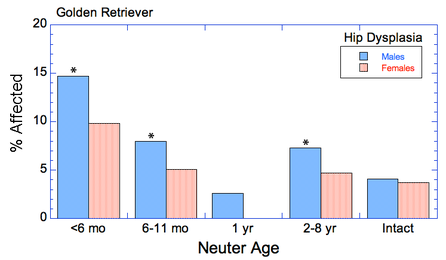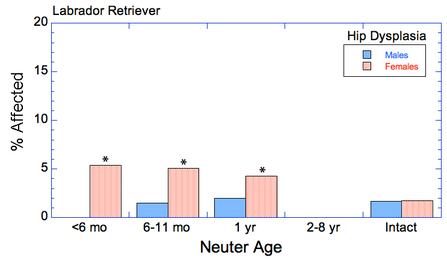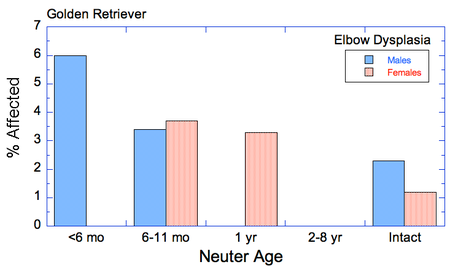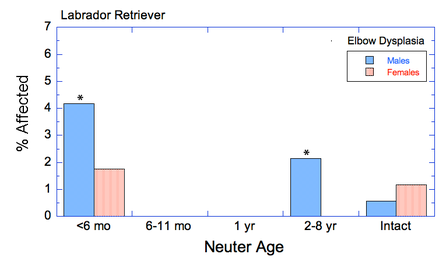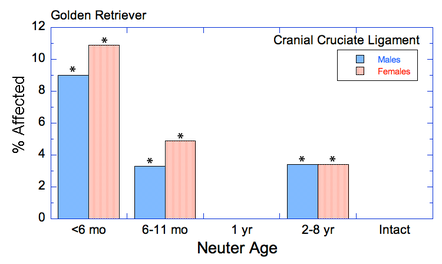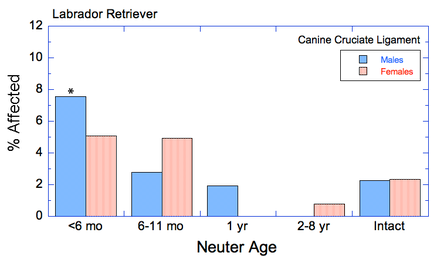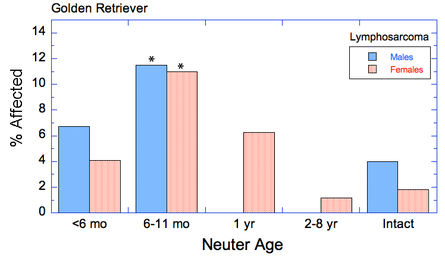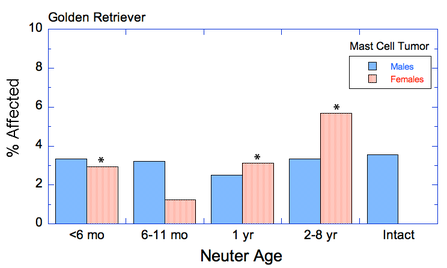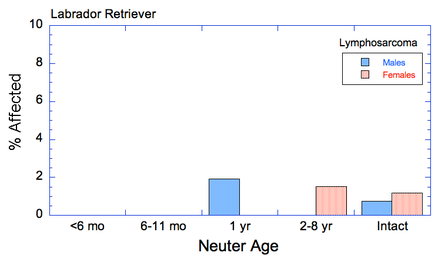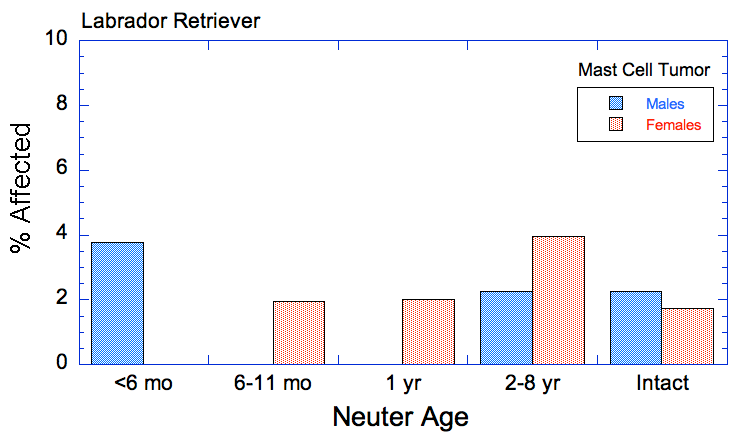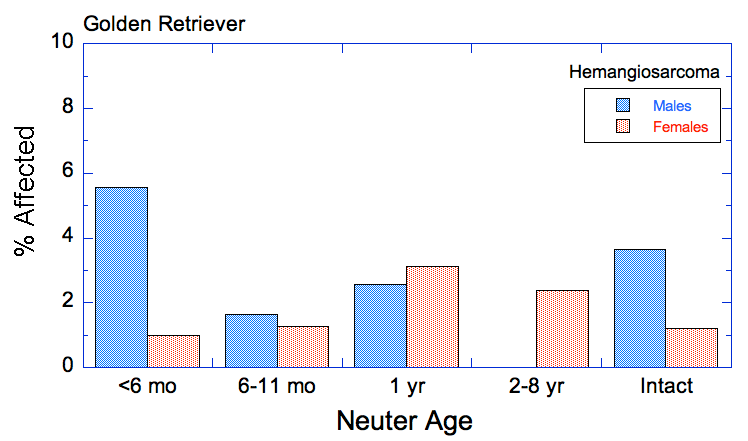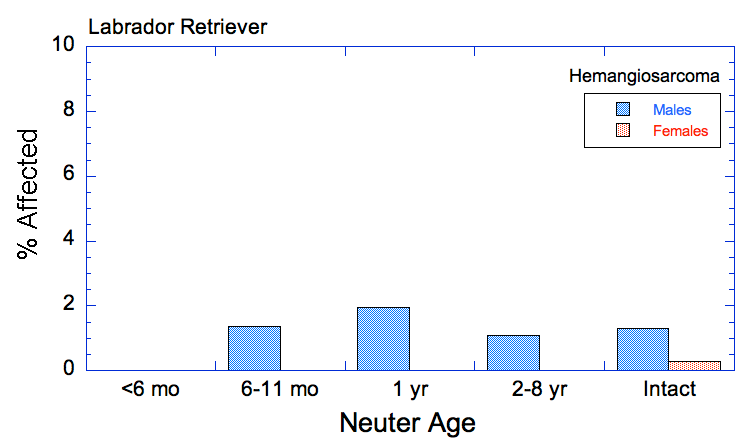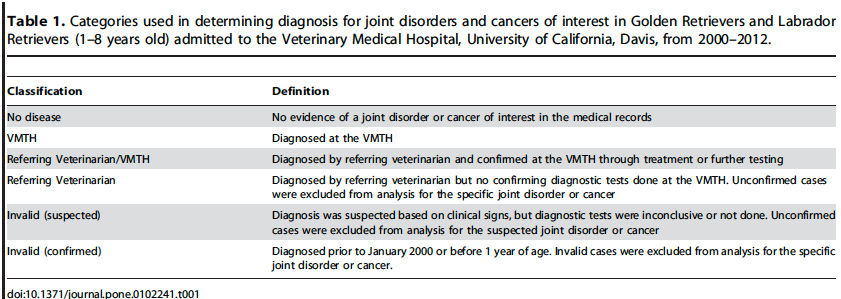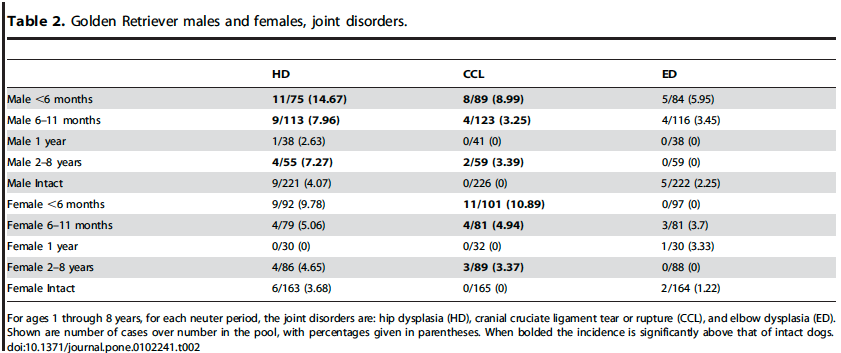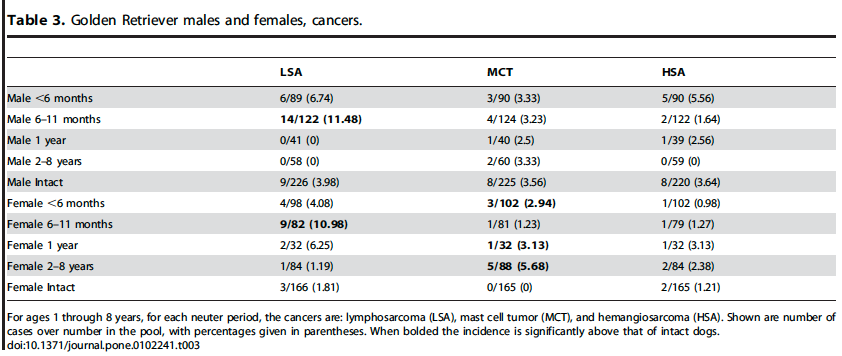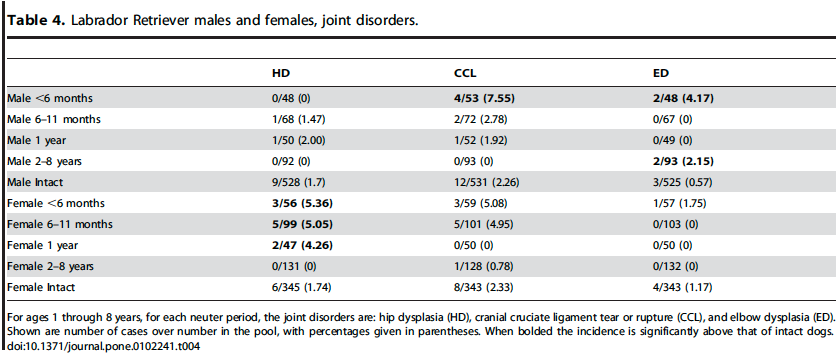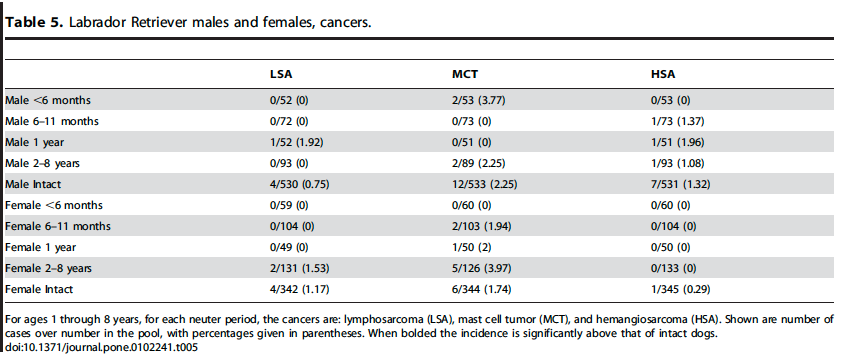Effects of Spay & Neuter
Data from -
- Hart, BL, LA Hart, AP Thigpen, & NH Willits 2014 Long-term health effects of neutering dogs: comparison of Labrador Retrievers with Golden Retrievers. PLoS ONE 9(7). (pdf)
Authors' Abstract
Our recent study on the effects of neutering (including spaying) in Golden Retrievers in markedly increasing the incidence of two joint disorders and three cancers prompted this study and a comparison of Golden and Labrador Retrievers. Veterinary hospital records were examined over a 13-year period for the effects of neutering during specified age ranges: before 6 mo., and during 6-11 mo., year 1 or years 2 through 8. The joint disorders examined were hip dysplasia, cranial cruciate ligament tear and elbow dysplasia. The cancers examined were lymphosarcoma, hemangiosarcoma, mast cell tumor, and mammary cancer.
The results for the Golden Retriever were similar to the previous study, but there were notable differences between breeds. In Labrador Retrievers, where about 5 percent of gonadally intact males and females had one or more joint disorders, neutering at <6 mo. doubled the incidence of one or more joint disorders in both sexes. In male and female Golden Retrievers, with the same 5 percent rate of joint disorders in intact dogs, neutering at <6 mo. increased the incidence of a joint disorder to 4-5 times that of intact dogs.
The incidence of one or more cancers in female Labrador Retrievers increased slightly above the 3 percent level of intact females with neutering. In contrast, in female Golden Retrievers, with the same 3 percent rate of one or more cancers in intact females, neutering at all periods through 8 years of age increased the rate of at least one of the cancers by 3-4 times.
In male Golden and Labrador Retrievers neutering had relatively minor effects in increasing the occurrence of cancers. Comparisons of cancers in the two breeds suggest that the occurrence of cancers in female Golden Retrievers is a reflection of particular vulnerability to gonadal hormone removal.
Our recent study on the effects of neutering (including spaying) in Golden Retrievers in markedly increasing the incidence of two joint disorders and three cancers prompted this study and a comparison of Golden and Labrador Retrievers. Veterinary hospital records were examined over a 13-year period for the effects of neutering during specified age ranges: before 6 mo., and during 6-11 mo., year 1 or years 2 through 8. The joint disorders examined were hip dysplasia, cranial cruciate ligament tear and elbow dysplasia. The cancers examined were lymphosarcoma, hemangiosarcoma, mast cell tumor, and mammary cancer.
The results for the Golden Retriever were similar to the previous study, but there were notable differences between breeds. In Labrador Retrievers, where about 5 percent of gonadally intact males and females had one or more joint disorders, neutering at <6 mo. doubled the incidence of one or more joint disorders in both sexes. In male and female Golden Retrievers, with the same 5 percent rate of joint disorders in intact dogs, neutering at <6 mo. increased the incidence of a joint disorder to 4-5 times that of intact dogs.
The incidence of one or more cancers in female Labrador Retrievers increased slightly above the 3 percent level of intact females with neutering. In contrast, in female Golden Retrievers, with the same 3 percent rate of one or more cancers in intact females, neutering at all periods through 8 years of age increased the rate of at least one of the cancers by 3-4 times.
In male Golden and Labrador Retrievers neutering had relatively minor effects in increasing the occurrence of cancers. Comparisons of cancers in the two breeds suggest that the occurrence of cancers in female Golden Retrievers is a reflection of particular vulnerability to gonadal hormone removal.
- NOTE: When this was originally posted, the summary below was inadvertently omitted.
- NOTE: The tables containing the data used for the graphs are appended at the bottom.
SUMMARY
The results of this study indicate that for MOST of the traits and age categories, spay/neuter had NO SIGNIFICANT EFFECT. Bars with asterisks indicate an effect that is significantly different from the value for intact dogs.
For cancers:
* there was NO significant effect for either breed at all age classes for hemangiosarcoma,
* there was NO significant effect for any cancer in Labradors.
* in Goldens there was ONLY a significant affect in females for mast cell tumor at 3 of 4 age classes
* for lymphosarcoma in Goldens, there was ONLY an effect in dogs neutered between 6-11 months.
*** So in terms of an effect on incidence of cancer, it was sex- and breed-specific for mast cell tumor, and affected only ONE age class of Goldens for lymphosarcoma.
For the orthopedic traits:
* Goldens spay/neutered males had increased incidence of hip dysplasia in all classes except 1 yr.
* there was NO effect of spay/neuter on hip dysplasia in female goldens.
* there was NO effect of spay/neuter on elbow dysplasia in goldens
* there was an effect ONLY for Labradors neutered/spayed before 6 mos and between 2-8 years
* CCL problems were increased in both male and female Goldens in 3 of the 4 age categories (not significant for dogs S/N at 1 yr
* in Labradors, there was an effect ONLY in males neutered before 6 mos.
*** For the orthopedic traits, S/N before 1 yr should be avoided.
These data do NOT scream "don't S/N". For the majority of these measurements, it has no effect at all. The data do certainly support the notion that dogs should be left intact until at least 1 y, as after that age the added risk for any of the things examined here is very low.
This study does indicate that there are some things worth further study - differences between breeds (Labs vs Goldens) in the response to S/N, including a potential effect of sex.
* Asterisk above a bar indicates a statistically significant difference from the intact level.
The results of this study indicate that for MOST of the traits and age categories, spay/neuter had NO SIGNIFICANT EFFECT. Bars with asterisks indicate an effect that is significantly different from the value for intact dogs.
For cancers:
* there was NO significant effect for either breed at all age classes for hemangiosarcoma,
* there was NO significant effect for any cancer in Labradors.
* in Goldens there was ONLY a significant affect in females for mast cell tumor at 3 of 4 age classes
* for lymphosarcoma in Goldens, there was ONLY an effect in dogs neutered between 6-11 months.
*** So in terms of an effect on incidence of cancer, it was sex- and breed-specific for mast cell tumor, and affected only ONE age class of Goldens for lymphosarcoma.
For the orthopedic traits:
* Goldens spay/neutered males had increased incidence of hip dysplasia in all classes except 1 yr.
* there was NO effect of spay/neuter on hip dysplasia in female goldens.
* there was NO effect of spay/neuter on elbow dysplasia in goldens
* there was an effect ONLY for Labradors neutered/spayed before 6 mos and between 2-8 years
* CCL problems were increased in both male and female Goldens in 3 of the 4 age categories (not significant for dogs S/N at 1 yr
* in Labradors, there was an effect ONLY in males neutered before 6 mos.
*** For the orthopedic traits, S/N before 1 yr should be avoided.
These data do NOT scream "don't S/N". For the majority of these measurements, it has no effect at all. The data do certainly support the notion that dogs should be left intact until at least 1 y, as after that age the added risk for any of the things examined here is very low.
This study does indicate that there are some things worth further study - differences between breeds (Labs vs Goldens) in the response to S/N, including a potential effect of sex.
* Asterisk above a bar indicates a statistically significant difference from the intact level.
Orthopedic Disorders
CANCER
